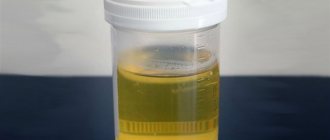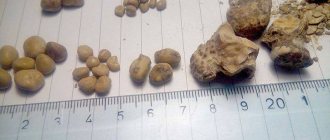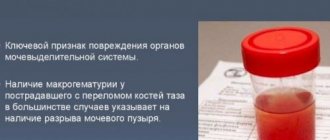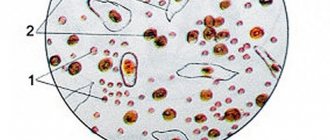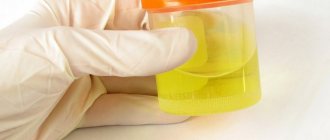The main indicators of metabolism in the body are reflected by urine analysis. It removes those metabolic products that are no longer beneficial to a person. You can track which substances and in what quantities are excreted or retained in the body. And if deviations from the norm of certain indicators are observed in the urine, we can assume the presence of pathological processes in the body.
One of the indicators of deviations is the presence of amorphous phosphates in urine. These are structureless salts that do not transform into crystals and are excreted in the urine as sediment. Despite the fact that the formations do not have a typical structure, sometimes they can form stones, which becomes a prerequisite for urolithiasis. If amorphous phosphates in the urine are temporary, their appearance can be associated with dietary habits. But sometimes this phenomenon may indicate the presence of diseases. Therefore, if phosphates are found in the urine, you need to find out the reasons for their appearance.
The process of formation of salts in urine
Phosphorus is present in the tissues of our body. Most of it (about 85%) is found in bones and teeth. Phosphates are salts that are formed as a result of the reaction of phosphoric acid with alkalis. They enter our body with food.
To perform its function in the body, phosphorus requires the presence of calcium. In symbiosis, they ensure the synthesis of protein and enzymes and regulate the process of muscle contraction. The phosphorus content in the body should normally be half the calcium content. If the concentration of phosphates begins to increase, this leads to leaching of calcium from the bones.
The concentration of its salts in the urine depends on the amount of phosphorus. Phosphate compounds are retained in the proximal renal tubules. About 12% of phosphates pass through filters and are excreted in the urine.
What is phosphaturia
Urine contains organic and inorganic substances. Some of them are in a dissolved state, others are insoluble and may precipitate. There are organized (organic) sediment formed by epithelial cells, formed elements, mucus, and unorganized (inorganic), which may include various salts, organic substances, and drug metabolites in the form of crystals or amorphous bodies. Inorganic salts form the basis of unorganized sediment.
Urine is a supersaturated solution of salts. Under certain conditions they precipitate. Such conditions occur with kidney disease or metabolic disorders. On the other hand, the formation of sediment leads to the formation of kidney stones.
In alkaline urine, sediment is formed by amorphous phosphates, neutral phosphates, tripelphosphates and other salts. Microscopy may reveal a whitish sediment in urine, which means that it contains amorphous phosphates.
The reference value for the content of inorganic phosphorus in urine is 29-45 mmol/day. A high level of this macroelement in urine indicates increased excretion from the body, which may indicate the presence of some pathology.
This is interesting: Spring exacerbation. Chronic pyelonephritis appears along with the kidneys
Reasons for the increase in indicators
An excess of amorphous phosphates in the urine of a healthy person is associated with alkalization of the body, which can be caused by dietary habits:
- reduction in animal proteins in the diet,
- abuse of dairy products, fish, seafood, canned food,
- frequent consumption of carbonated drinks, coffee, alkaline mineral waters.
Learn how to prepare for bladder instillation and how the procedure is performed.
The rules for using madder tablets for kidney treatment are written on this page.
In addition to poor nutrition, pathological conditions can be the causes of amorphous phosphates in the urine:
- phosphate poisoning,
- congenital anomalies of the renal tubules,
- renal phosphate diabetes,
- urolithiasis disease,
- cystitis,
- hyperparateriosis,
- renal tubular acidosis,
- hyperfunction of the parathyroid glands,
- dehydration of the body caused by frequent vomiting, diarrhea,
- chronic renal failure.
Symptoms
If there is a small amount of amorphous phosphorus salts in the urine, then this may not affect the general condition of the person. Especially if the cause of their appearance was poor nutrition.
But if phosphates in the urine appear against the background of diseases, then sooner or later they will manifest themselves with other symptoms. If phosphaturia is present for a long time, then cloudiness of the urine and the appearance of foreign sediment in it are noted.
The presence of salts in the body may be indicated by:
- frequent urge to urinate,
- pain in the lumbar region, which becomes more intense when bending, turning,
- Sometimes there may be abdominal cramps, nausea, and flatulence.
Phosphaturia during pregnancy
This is a common occurrence for women during this period. Salts in the urine are more often found during toxicosis in the early stages of pregnancy and at the end of the last trimester. With frequent vomiting and nausea, a woman has to reconsider her diet. Often food becomes of the same type, which creates conditions for the precipitation of phosphate salts.
Phosphaturia in pregnant women can occur due to problems with the urinary system. The patient needs to see a nephrologist and have an ultrasound of the kidneys and bladder done. It is important to eliminate the inflammatory process in a timely manner in order to prevent the infection from spreading further and not affecting the development of the fetus.
On a note! Pregnancy is accompanied by an increase in progesterone levels. The hormone relaxes muscle tissue, causing urine to stagnate longer in the bladder and increasing salt concentration. Women are advised to move more and strengthen their pelvic muscles with special exercises.
Methods of therapy for phosphaturia
Drug therapy is used for exacerbation of chronic pathology, the appearance of stones in the kidneys and bladder. Tablets are prescribed only if absolutely necessary. This is due to the high degree of negative impact of active compounds on the fetus contained in the preparations. The most unfavorable period is the first trimester. At this time, the fetus is actively growing, organs and systems are being formed. In recent months, only after consulting a doctor can you decide on taking medications.
Amorphous crystals in the urine are a symptom that can be eliminated by following a certain diet. During pregnancy, a woman should not only exclude harmful foods. For this reason, the doctor explains what is recommended to eat and what you should eat little of.
Amorphous phosphates in the urine of a child
In children, phosphates are detected only in amorphous form. A small number of them are detected before the age of five. Some functions of the body are not yet fully formed; when you change your diet, the body may react in a special way.
When amorphous phosphates are first detected in the urine, the child’s diet should be changed and a repeat urine test should be done a few days later. This will make it possible to determine whether the appearance of salts is related to nutrition or whether the cause should be sought in pathological changes. Children's nutrition should be balanced, including a sufficient amount of not only plant, but also animal proteins and carbohydrates.
If phosphates are detected repeatedly, this may be a signal of disease. More often this is rickets, in which there is a deficiency of vitamin D in the body (the daily norm for a child is 300-600 IU). Typically, rickets manifests itself in infants and children of primary preschool age. In addition to phosphates in the urine, a high concentration of calcium and phosphorus may be present in the blood test.
With rickets, children's limbs are bent and the bone skeleton is deformed. Muscle tissue is flabby, skin is pale.
Diagnosis of indicator levels
Phosphaturia is diagnosed using a general urine test. Normally, an adult should receive about 1200 mg of phosphates per day. About 800 mg should be excreted in the urine. In a urine test, the salt level is indicated by the sign “,+”, in an amount of 1-4. A + or ++ reading in the sample is normal. If there are more pluses, this indicates a violation of salt metabolism.
To obtain more reliable and detailed information about the presence of amorphous phosphates and the dynamics of their concentration, it is recommended to collect daily urine (Zimnitsky analysis).
Rules for collecting urine for analysis
To get reliable results, it is recommended:
- 7 days before the test, exclude from the diet foods that contribute to the alkalization of urine (smoked foods, sweets, alcohol).
- Buy special containers for collecting material from the pharmacy.
- If you need to do a general urine test, take a mid-morning urine sample on an empty stomach and deliver it to the laboratory within 2 hours.
- If you intend to collect daily urine, the first portion should be collected at 6 am and a new container should be filled every 3 hours.
- Before urinating, be sure to wash yourself without using soap so that foreign impurities do not get into the material.
- Store the collected urine in a cool, dark place (not in the refrigerator), the container is carefully sealed.
- On each container you need to indicate the time of the collected urine portion and the patient’s initials.
Diagnostics
The first stage of diagnosis is a general urine test . Its pH changes towards alkalization, that is, it becomes more than 7.0; upon microscopic examination, grayish grains are visible. If there are a lot of salts, then they are noticeable even without a microscope. The result is recorded on the analysis form with crosses (+). One cross is the minimum phosphate content, four crosses is the maximum.
It is impossible to judge serious changes in metabolism from one analysis. Therefore, if salts are detected, it must be taken again after correcting the diet. For 1-2 weeks, you need to exclude carbonated drinks, alkaline mineral water, alcohol, reduce the consumption of salt, fish, dairy products, vegetables, and increase the amount of meat dishes.
If after this the phosphate level remains high, then proceed to the second stage of diagnosis - searching for the cause of phosphaturia. This may require determination of blood levels of hormones, electrolytes, glucose, kidney function indicators (glomerular filtration rate, creatinine, urea), culture and daily urine analysis, ultrasound of the thyroid gland, bladder, kidneys. You may need to do a survey X-ray of the abdominal cavity and excretory urography.
General rules and methods of treatment
The main goal of therapeutic measures is to prevent amorphous phosphates from transforming into stones. Drug treatment is resorted to if the cause of the increased phosphate content is pathological.
If hormonal imbalance occurs, it is necessary to consult an endocrinologist who will prescribe hormone replacement therapy. Inflammations of the urinary system are carried out under the supervision of a urologist or nephrologist. If the infection occurs due to bacterial microflora, a course of antibiotics is prescribed taking into account the sensitivity of the pathogen.
For urolithiasis, both conservative and surgical treatment methods can be used. If the stones are small and can pass through the ureter on their own, diuretics are prescribed, as well as drugs that dissolve stones (phosphates, unlike oxalates, dissolve well). For large formations, stones need to be crushed through surgery. Laparoscopy remains one of the most painless and effective methods of intervention. In case of renal failure, hemodialysis is used.
Learn about the signs of renal colic in women and how to relieve pain.
A list of effective medications for cystitis and the rules for their use can be seen in this article.
Go to https://elesto.ru/diagnostika/analizy/krasnaya-mocha.html and read about the causes of red urine in women and treatment options for concomitant diseases.
Diet and nutrition rules
The main emphasis in phosphaturia is on nutritional correction. Any alkalizing foods are excluded from the diet. To prevent the formation of phosphorus-calcium salts, it is recommended to adhere to treatment table No. 14. For normal functioning of the urinary system and to accelerate the elimination of residual salts, you must also adhere to a plentiful drinking regime (about 2.5 liters per day).
List of recommended and prohibited products for phosphaturia:
Useful tips
To prevent the appearance of salts in the urine, it is necessary to follow certain dietary and lifestyle rules:
- do not abuse smoked meats, spicy, sour, salty foods,
- drink enough fluids, diuretics,
- don't get too cold,
- promptly treat urinary tract infections,
- in order to avoid vitamin D deficiency and the development of rickets, it is enough for children to be exposed to sunlight or consume the vitamin in the form of a solution,
- Conduct a preventive examination with a urologist at least 2 times a year, take a general urine test, and do an ultrasound.
Amorphous phosphates in the urine are not necessarily a symptom of disease. Their appearance may be associated with dietary errors and physiological changes during pregnancy. To find out the cause of errors in urine readings, a number of additional studies need to be conducted. The presence of salts in urine should not be ignored, even if a person does not experience any discomfort. Phosphaturia may hide diseases whose treatment should not be delayed.
Children's doctor Komarovsky will tell you more about the reasons for the appearance of amorphous phosphates in the urine of a child and about ways to bring the indicators back to normal in the following video:
Diagnostic methods
Laboratory diagnostics help determine the presence of crystals; most often, the most informative general urine test . It allows you to determine the quantitative value of urates, phosphates and calcium crystals. The most accurate will be microscopic examination.
The most accurate will be a biochemical blood test ; more in-depth research methods are also used - urine analysis according to Zimnitsky and Nechiporenko .
If the pain is constant, an ultrasound examination of the kidneys in the problem area is prescribed.
Rules for collecting material
To obtain reliable results, you must follow the rules for collecting urine for analysis.
Particular attention is paid to avoiding alcohol, smoking, excessive physical activity and eating fatty and spicy foods at least 2 days before the test. Before collecting biomaterial, the genitals should be thoroughly washed with soap.
